Hemiramphidae is a family of fishes that are commonly called halfbeaks, spipe fish or spipefish. They are a geographically widespread and numerically abundant family of epipelagic fish inhabiting warm waters around the world. The halfbeaks are named for their distinctive jaws, in which the lower jaws are significantly longer than the upper jaws. The similar viviparous halfbeaks have often been included in this family.

The Ganges river dolphin is a species of toothed whale classified in the family Platanistidae. It lives in the Ganges and related rivers of South Asia, namely in the countries of India, Nepal, and Bangladesh. It is related to the much smaller Indus river dolphin which lives in the Indus River in Pakistan and the Beas River of northwestern India.

Sundarbans is a mangrove area in the delta formed by the confluence of the Ganges, Brahmaputra and Meghna Rivers in the Bay of Bengal. Sundarban Reserve Forest (SRF) of Bangladesh is the largest mangrove forest in the world. It spans the area from the Baleswar River in Bangladesh's division of Khulna to the Hooghly River in India's state of West Bengal. It comprises closed and open mangrove forests, land used for agricultural purpose, mudflats and barren land, and is intersected by multiple tidal streams and channels. Sundarbans is home to the world's largest area of mangrove forests. Four protected areas in the Sundarbans are enlisted as UNESCO World Heritage Sites, viz. Sundarbans West (Bangladesh), Sundarbans South (Bangladesh), Sundarbans East (Bangladesh) and Sundarbans National Park (India).
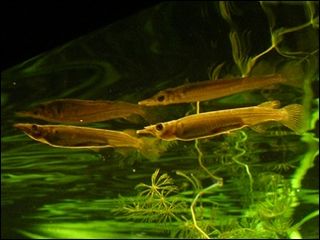
The wrestling halfbeak also known as Malayan halfbeak is a species of viviparous halfbeak native to the fresh and brackish waters of rivers and coastal regions in South-East Asia, in Singapore, Thailand, Indonesia, Thailand, Malaysia, Borneo and Sumatra. It is a small, slender, livebearing fish, with the elongated lower jaw characteristic of its family. The colour of this species varies, depending on where the specimen is found. It is the type species of the genus Dermogenys.

The northern river terrapin is a species of riverine turtle native to Southeast Asia. It is classified Critically Endangered by the IUCN and considered extinct in much of its former range.
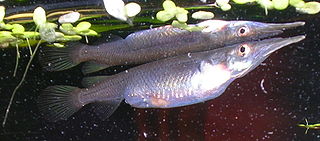
Dermogenys is a genus of viviparous halfbeaks. They are widely distributed in fresh and brackish water in South and Southeast Asia, ranging from India to the Philippines and Greater Sundas. They are all viviparous, producing small clutches of up to 30 fry that closely resemble the adults, except they are much smaller, around 1–1.5 cm (0.4–0.6 in) in length. Adults are typically around 6–7 cm (2.4–2.8 in) in length, with females being slightly larger than males. Males tend to be more brightly coloured and are well known for being aggressive towards one another. The wrestling halfbeak, D. pusilla, is widely used in Asia as fighting animals upon which wagers are placed. Both sexes have lower jaws (mandibles) that are much longer than the upper ones, and from this comes the "halfbeak" name.

The pool barb, spotfin swamp barb, or stigma barb is a tropical freshwater and brackish fish belonging to the Puntius genus in the family Cyprinidae. It is native to inland waters in Asia and is found in India, Nepal, Bangladesh, Myanmar, Bhutan, Afghanistan, Pakistan and Yunnan, China.

Vikramshila Gangetic Dolphin Sanctuary is located in Bhagalpur District of Bihar, India. The sanctuary is a 60 kilometers stretch of the Ganges River from Sultanganj to Kahalgaon in Bhagalpur district. notified as Vikramshila Gangetic Dolphin Sanctuary in 1991, it is the protected area for the endangered Gangetic dolphins in Asia. Once found in abundance, only a few hundred remain, of which half are found here.

Anabas cobojius, the Gangetic koi, popularly known as Koi in Bengali is a species of climbing gourami native to Bangladesh and India, where it occurs in many types of standing water bodies. This species reaches a total length of 30 cm (12 in) and is carnivorous, feeding on water invertebrates and their larvae. It is of commercial importance as a food fish in its native range. In addition to being fished, it may be threatened by siltation from deforestation and agricultural activities, pollution and habitat change by hydropower and dam development. The exact population is unknown. It spawns once during the rainy season from May–July.
The Congaturi halfbeak, also known as the Valenciennes halfbeak, is a potamodromous species of fish in the family Hemiramphidae. It is a valued commercial fish in tropical countries both dried salted and fresh forms.

Zenarchopteridae, the viviparous halfbeaks, is a family in the order Beloniformes. The Zenarchopteridae exhibit strong sexual dimorphism, practicing internal fertilisation, and in some cases ovoviviparous or viviparous. The members in the family are mainly found in fresh and brackish water of tropical Asia and New Guinea, but the genus Zenarchopterus also includes marine species from the Indo-Pacific. Several, such as the wrestling halfbeak, have become commonly traded aquarium fish.

The rice-paddy eel is an eel in the family Ophichthidae. It was described by Francis Buchanan-Hamilton in 1822, originally in the genus Ophisurus. It is a tropical, marine eel which is known from the Indo-West Pacific, including Somalia, Tanzania, South Africa, India, Sri Lanka, Indonesia, Polynesia, Australia, Bangladesh, Cambodia, Kenya, Madagascar, the Philippines, Malaysia, Mozambique, Seychelles, Saudi Arabia, Taiwan, China, Thailand, Vietnam, and southern Yemen. It is an anadromous species and spawns in freshwater, often in rice paddies during the rainy season, earning it its common name. It also spends time in lagoons, estuaries and coastal rivers, in which it lives in burrows in the river bottom and bank. Males can reach a maximum total length (TL) of 100 centimetres, but more commonly reach a TL of 70 cm.
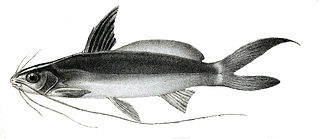
Mystus cavasius, the Gangetic mystus, is a species of catfish of the family Bagridae.
The feathered river garfish, also known as the estuarine halfbeak, spoon-fin garfish, spoon-fin river garfish and viviparous half beak, is a species of marine, freshwater, brackish and reef-associated oceanodromous viviparous halfbeak found in Indo-Pacific regional countries, such as Kenya, Mozambique, Seychelles, Madagascar, New Guinea, Solomon Islands, Australia, New Caledonia, Fiji, Sri Lanka, India, Vanuatu, Malaysia, Thailand, Singapore and Samoa.

Datnioides polota, commonly known as the silver tigerfish or four-banded tiger perch, is a species of datnioidid fish native to brackish and fresh waters near the coast like mangrove, lagoons, estuaries and lower parts of rivers from northeastern India, through Bangladesh and mainland southeast Asia, to Sumatra and Borneo. Although sometimes reported from New Guinea, this population is now recognized as D. campbelli. D. polota is a predatory fish that reaches up to 30 cm (1 ft) in standard length.
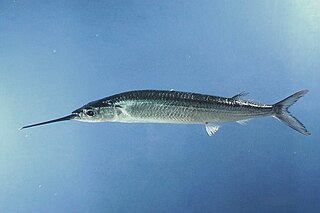
Hyporhamphus unifasciatus, the common halfbeak or the Atlantic silverstripe halfbeak, is a bony fish in the family Hemiramphidae. It is found in the subtropical western Atlantic Ocean and the Gulf of Mexico. It is a common fish and not used for food to any great extent, and the International Union for Conservation of Nature has listed its conservation status as being of "least concern".
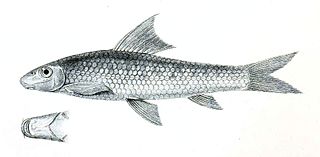
Tariqilabeo latius, also known as the stone roller or Gangetic latia, is a species of ray-finned fish in the genus Tariqilabeo. It is found in India, Bangladesh, Myanmar, Nepal, and China.

The corsula is a species of ray-finned fish from the grey mullet family Mugilidae. It is found in the rivers and estuaries of southern Asia, in India, Bangladesh, Nepal and Myanmar. It is presently regarded as the only species in the monospecific genus Rhinomugil.

Chelonodontops patoca, also known as the milk-spotted pufferfish, milkspotted puffer, milkspotted toadfish, Gangetic blow fish, Gangetic pufferfish, or marbled toad, is a species of pufferfish in the family Tetraodontidae native to the Indo-Pacific. It ranges from East Africa to the Western Pacific from Korea in the north to northern Australia in the south. It is a tropical species that occurs in coastal waters, lagoons, estuaries, and rivers. While it does enter fresh water, the species does not occur more than a few kilometres from the sea. It is often seen in schools which sometimes enter freshwater streams. It is usually found at a depth range of 4 to 60 m and reaches 38 cm (15 in) standard length. The species is poisonous but reportedly considered a delicacy in Japan.















